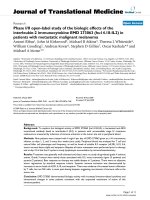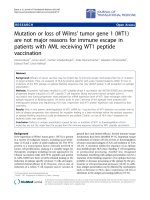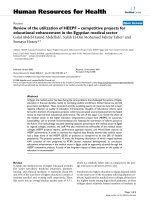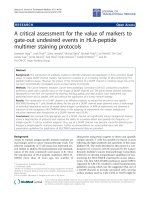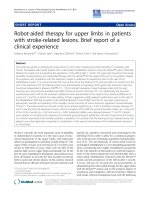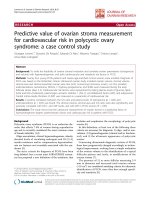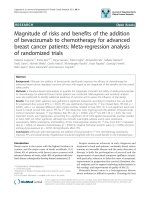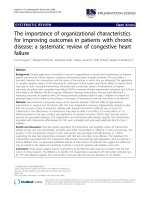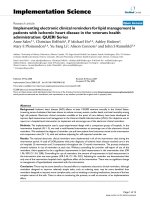The value of malnutrition-inflammation-atherosclerosis (MIA) syndrome for predicting mortality in patients with end-stage renal disease at Hue Central Hospital
Bạn đang xem bản rút gọn của tài liệu. Xem và tải ngay bản đầy đủ của tài liệu tại đây (862.08 KB, 8 trang )
Life Sciences | Medicine
Doi: 10.31276/VJSTE.61(2).52-59
The value of malnutrition-inflammation-atherosclerosis
(MIA) syndrome for predicting mortality in patients
with end-stage renal disease at Hue Central Hospital
Thi Khanh Trang Ngo, Bui Bao Hoang*, Tam Vo
University of Medicine and Pharmacy - Hue University
Received 20 October 2018; accepted 5 March 2019
Abstract:
Background: the role of malnutrition, inflammation, atherosclerosis, and particularly the combination of these
three factors were closely related to cardiovascular events, hospitalisation frequency, and death in end-stage renal
disease (ESRD) patients. This study examines the relationship between malnutrition-inflammation-atherosclerosis
(MIA) syndrome and mortality among these patients during an 18-month period.
Subjects and methods: in this prospective observational cohort study, all cause-mortality was evaluated during an
18-month follow-up period. A total of 174 patients with ESRD (including 57 non-dialysis patients, 56 peritoneal
dialysis patients, and 61 hemodialysis patients) were enrolled. M (malnutrition) was assessed by the seven-point
subjective global assessment (SGA), serum albumin. I (inflammation) was assessed by serum hs-CRP, serum IL-6.
A (atherosclerosis) was defined as IMT ≥0.9 mm or the presence of plaque in the carotid artery. The patients are
classified into four groups by number of components (MIA0, MIA1, MIA2, MIA3).
Results: 73.6% of patients had at least one component of MIA syndrome. The proportion of patients with
malnutrition, inflammation, and atherosclerosis accounted for 36.8%, 21.3%, and 50.6%, respectively. The
proportion of patients with 3, 2, 1 component accounted for 4.0, 27.0, and 42.5%. There was no difference between
MIA groups based on age, sex, percentage suffering from dyslipidemia, anemia, or Hb levels. Relative to patients
experiencing no elements of MIA syndrome, patients with three components experienced a 13.16 times higher
risk of mortality. Only malnutrition was a strong predictor of mortality with HR (95% CI): 5.90 (2.46-14.14).
Conclusion: clinical physicians should attend more closely to and provide early assessments of MIA syndrome in
patients with ESRD. They should care for nutrition conditions and thereby provide early and effective treatments.
This can contribute to enhancements in quality of life, and decrease mortality rates in patients.
Keywords: end-stage renal disease, malnutrition-inflammation-atherosclerosis syndrome, MIA syndrome.
Classification number: 3.2
Introduction
Chronic kidney disease (CKD) is a global health
problem which has received substantial attention in
medicine because it has become increasingly common.
This has increased treatment costs and decreased quality
of life. Patients with CKD have received improved
care by many measures, which has advanced patients’
lifespans and considerably enhanced disease prognoses.
However, the mortality rate among patients with endstage renal disease (ESRD) remains high, and deaths
associated with cardiovascular events are the most
concerning. Many researchers have demonstrated the
role of malnutrition, inflammation, and atherosclerosis in
these outcomes, and particularly the combination of the
three factors was closely associated with cardiovascular
events, hospitalisation frequency, and death among these
patients [1-3]. Nephrologists are currently concerned about
the treatment, quality of life advancement, and minimisation
of mortality rates among patients with CKD. In Vietnam,
although a complete study has not determined the number
of CKD patients yet, it was estimated that 20,000 ESRD
patients were under treatment with the renal replacement
therapy. The mortality of this population has not been
*Corresponding author: Email:
52
Vietnam Journal of Science,
Technology and Engineering
JUne 2019 • Vol.61 Number 2
Life Sciences | Medicine
investigated yet. Therefore, this study was designed to
examine the prognostic value of malnutrition-inflammationatherosclerosis (MIA) syndrome regarding mortality during
an 18-month follow-up with ESRD patients.
Methods
<40 g/l [4]. I (inflammation) was defined as serum hsCRP level >5 mg/l (upper reference values) combined with
serum IL-6 level >5.53 pg/ml (upper reference values).
A (atherosclerosis) was defined as IMT ≥0.9 mm or the
presence of plaque in the carotid artery [5].
The patients were classified into for groups based on the
number of the components: MIA0, MIA1, MIA2, MIA3.
Ethics statement
This study was approved by the Research and Ethical
Committees for the use of human subjects at Hue University
of Medicine and Pharmacy; informed consent from the
patients is required.
Study design and patients
This is a prospective observational cohort study with no
treatment interventions; all cause-mortality was recorded
during the 18-month follow-up period. Convenience
sampling was used for the research, and all subjects eligible
were invited to participate.
This research was performed at the department of
Nephrology and the Department of Dialysis at Hue Central
Hospital in Hue city, Vietnam, from 1/2014 to 2/2017. A
total of 174 patients with ESRD (including 57 non-dialysis
patients, 56 peritoneal dialysis patients, and 61 hemodialysis
patients) were enrolled.
In terms of patient selection criteria patients with ESRD
who were at least 18 years old, agreed to participate in
the study. Non-dialysis patients with glomerular filtration
<15 ml/min/1.73 m2 (eGFR based on formula of CKD-EPI
2009) were enrolled. Additionally, continuous ambulatory
peritoneal dialysis patients had been stable for at least
two months (when the postoperative catheter placement
was stable and the patient had mastered the procedure).
Hemodialysis patients were treated three times weekly for
at least three months.
The exclusion criteria applied included fever (defined as
axillary temperature >37.50C), acute or chronic infection,
and patients accompanied by one of the following diseases
or conditions: cerebrovascular disease, coronary artery
disease, peripheral vascular disease, congenital heart
disease, heart valve disease, arthritis, malignant disease,
chronic lung disease, cirrhosis, autoimmune disease, trauma,
acute exacerbation of chronic kidney failure, complications
related to peritoneal dialysis patients such as catheter issues,
herniae, and hydrothorax, fistula vein stenosis, or renal
transplantation.
Definition of MIA factors and grouping
M (malnutrition) was measured with the seven-point
SGA (if items SGA ≤5 points with no manifestations of
normal nutrition) combined with serum albumin levels
Techniques applied in this research
Venous blood samples were taken in the morning after
an overnight fast, and prior to dialysis. A machine of Cobas
e 501 was used for quantifying chemo-biological indices
(albumin, total cholesterol, triglyceride, HDL-C, LDL-C,
hs-CRP), of IMMULITE 2000 XPI for quantifying plasma
IL-6 levels.
An Acuson X500 Ultrasound Machine was used for the
diagnosis of atherosclerosis of the carotid artery. 7-5
MHz linear transducers were used for the assessment of
the intima-media thickness and plaque morphology. This
technique was performed by an experienced radiologist.
Collecting information regarding mortality during the
18-month follow-up period
Non-dialysis patients: made contact with the patients by
phone. They received reexamination once every month. This
enabled us to collect important information regarding
disease progress (including events, death), treatment
compliance, and patients’ and their families’ thoughts and
desires regarding treatment choices for kidney failure.
After monitoring for 18 months, we discovered the
following change in the quantity in the non-dialysis group:
Firstly, 28 patients who had received renal replacement
therapy with peritoneal dialysis and hemodialysis were
excluded from the analysis because our aim is solely to
conduct observational research, as opposed to treatment
intervention.
Secondly, among the other 29 patients, 19 patients and
their families initially refused renal replacement therapy
and asked for dialysis delay. 18 months later, they also
received dialysis. The other 10 patients had glomerular
filtration rates at 10-15 ml/minute. Because there were not
yet symptoms associated with uremia and events (volume
overload, metabolic abnormalities...), there were no
indications of dialysis. This group was periodically treated
and monitored. Therefore, for 18 months, there had still
been 29 patients who received medical treatment and then
dialysis. Therefore, for the analysis of the prognostic value
of MIA syndrome, only 146 patients remained.
Patients with peritoneal dialysis and hemodialysis were
monitored through appointments each month (patients
JUne 2019 • Vol.61 Number 2
Vietnam Journal of Science,
Technology and Engineering
53
Life Sciences | Medicine
with peritoneal dialysis) and through each dialysis session
(patients with hemodialysis). Deaths were recorded based
on outpatient medical records.
Malnutrition (M)
n=64 (36.8%)
Our data only indicated the clinical value of MIA
syndrome for predicting all-cause mortality in patients with
ESRD.
Results
Initially, the 174 patients (83 males and 91 females)
included 57 non-dialysis patients, 56 peritoneal dialysis
patients, and 61 hemodialysis patients. The average ages
of these research subjects were 48.11±15.10, among whom
non-dialysis patients were 50.83±16.67, peritoneal dialysis
patients were 47.66±12.82; and hemodialysis patients were
45.98±15.36 (Tables 1, 2; Fig. 1).
No factors of
MIA
n
%
n
%
Non-dialysis (n=57)
42
73.7
15
26.3
Peritoneal dialysis (n=56)
41
73.2
15
26.8
Hemodialysis (n=61)
45
73.8
16
26.2
Total
128
73.6
46
26.4
p
>0.05
Group
Group
MIA2
MIA1
MIA0
n
n
n
n
%
%
%
12 (6.9%)
Non-dialysis (n=57)
3
5.3
18
31.6
21
36.8
15
26.3
2
3.6
14
25.0
25
44.6
15
26.8
Hemodialysis (n=61)
2
3.3
15
24.6
28
45.9
16
26.2
Total
7
4.0
47
27.0
74
42.5
46
26.5
p
>0.05*
* Fisher test.
54
Vietnam Journal of Science,
Technology and Engineering
>0.05
>0.05
>0.05
7
n=88 (50.6%)
29 (16.7%)
40 (23.0%)
12 (6.9%)
Relationshipsbetween
between components
components of
Fig.Fig.
1. 1.
Relationships
ofMIA
MIAsyndrome
syndromeamong the patient
Notably,
26.5% of the patients experienced no malnutrition, inflammation,
among
the patients.
atherosclerosis.
Notably,
26.5% of the patients experienced no malnutrition,
inflammation, or atherosclerosis.
During the 18-month follow-up period, 25 patients died from all causes.
differences
observedfollow-up
in terms ofperiod,
age, sex,
of patients with anem
During thewere
18-month
25 percentage
patients died
dyslipidemia, or treatment methods between the non-survival and survival groups (Ta
from
3). all causes. No differences were observed in terms of
age, sex, percentage of patients with anemia, dyslipidemia,
Table 3. Comparison between initial data among the non-survival group as oppos
or treatment
methods between the non-survival and survival
to the survival group.
groups (Table 3).
Non-survivals
Survivals
(n=25)
(n=121)
P-value
50.24±16.42
47.92±14.76
>0.05
Parameters
Table
3. Comparison between initial
n data %among nthe non%
survival group as opposed to the survival group.
Age (years)
Male
Sex
Parameters
Patients with
anemia
Age (years)
Female
Yes
No
±SD
Patients with MaleYes
No
Sexdyslipidemia
Patients with
anemia
Patients with
dyslipidemia
Treatment
method
%
Peritoneal dialysis (n=56)
6 (3.5%)
(4.0%)
Table 2. Percentage of patients by number of MIA elements.
MIA3
Atherosclerosis (A)
n=37 (21.3%)
Table 1. Percentage of patients who experienced at least one
element of MIA.
Experienced at least
one factor of MIA
n=46 (26.5%)
22 (12.6%)
Inflammation (I)
Statistical analysis
All statistical analyses were performed using SPSS
V22.0 (Statistical Package for Social Sciences). Quantitative
variables were expressed as the mean ± standard deviation.
Qualitative variables were expressed in terms of frequencies
and percentages. Two ratios were compared using a
Chi-squared test. An ANOVA test was used to compare
means between groups. The COX model and the
Kaplan-Meier method were used to investigate survival
factors. The Kaplan-Meier method was used to analyse
cumulative survival probability, and the COX model was
applied to investigate the prognostic value of elements of
MIA syndrome in relation to all-cause mortality. Differences
with p<0.05 were considered statistically significant.
None
Non-survivals
8
(n=25)
Survivals
32.0
(n=121)
64
n
n 96.0%
106
17
% 24
1
50.24±16.42
68.0
57 P-value
47.1
87.6
4.0
15 >0.05 12.4
47.92±14.76
8
32.019
Female
17
68.0
57
Yes
24
96.0
106
87.6
No
1
4.0
15
12.4
Yes
19
76.0
87
71.9
No
6
24.0
34
28.1
Non-dialysis
5
20.0
24
19.8
Peritoneal
dialysis
10
40.0
46
38.0
Hemodialysis
10
40.0
51
42.2
6
52.9
64 76.052.9 87
24.0
47.1
71.9
34 >0.05 28.1
>0.05
>0.05
>0.05
The probability of survival was diminished in
malnourished patients (Table 4 and Fig. 2). Meanwhile,
there was no significant difference in the probability of
survival between patients with and without inflammation
(Table 5 and Fig. 3). This was also noted between patients
with and without atherosclerosis (Table 6 and Fig. 4).
JUne 2019 • Vol.61 Number 2
>0.05
>0.05
>0.05
Life Sciences | Medicine
Table 4. Probability of survival for patients with and without malnutrition.
Group
Non-dialysis (n=29)
Malnutrition
Peritoneal dialysis (n=56)
Hemodialysis
(n=61)
Total
(n=146)
Non-survivals
(n=5)
Survivals
(n=24)
Non-survivals
(n=10)
Survivals
(n=46)
Non-survivals Survivals
(n=10)
(n=51)
Non-survivals
(n=25)
Survivals
(n=121)
n
%
n
%
n
%
n
%
n
%
n
%
n
%
n
%
Yes
5
41.7
7
58.3
7
35.0
13
65.0
6
33.3
12
66.7
18
36.0
32
64.0
No
0
0.0
17
100.0
3
8.3
33
91.7
4
9.3
39
90.7
7
7.3
89
92.7
p Log Rank
<0.05
<0.05
<0.05
<0.001
Fig. 2. Kaplan-Meier survival curves for patients with and without malnutrition.
Table 5. Probability of survival for patients with and without inflammation.
Group
Non-dialysis (n=29)
Peritoneal dialysis (n=56)
Hemodialysis
(n=61)
Non-survivals
(n=5)
Survivals
(n=24)
Non-survivals
(n=10)
Survivals
(n=46)
Non-survivals
(n=10)
Survivals
(n=51)
Non-survivals
(n=25)
Survivals
(n=121)
n
%
n
%
n
%
n
%
n
%
n
%
n
%
n
%
Yes
3
42.9
4
57.1
2
15.4
11
84.6
1
7.1
13
92.9
6
17.6
28
82.4
No
2
9.1
20
90.9
8
18.6
35
81.4
9
19.1
38
80.9
19
17.0
93
83.0
p Log Rank
<0.05
Inflammation
>0.05
Total
(n=146)
>0.05
JUne 2019 • Vol.61 Number 2
>0.05
Vietnam Journal of Science,
Technology and Engineering
55
Life Sciences | Medicine
Fig. 3. Kaplan-Meier survival curves for patients with and without inflammation.
Table 6. Probability of survival for patients with and without atherosclerosis.
Group
Non-dialysis (n=29)
Peritoneal dialysis (n=56)
Hemodialysis (n=61)
Total (n=146)
Non-survivals
(n=5)
Survivals
(n=24)
Non-survivals
(n=10)
Survivals
(n=46)
Non-survivals
(n=10)
Survivals
(n=51)
Non-survivals
(n=25)
Survivals
(n=121)
n
%
n
%
n
%
n
%
n
%
n
%
n
%
n
%
Yes
5
29.4
12
70.6
5
19.2
21
80.8
5
15.6
27
84.4
15
20.0
60
80.0
No
0
0.0
12
100.0
5
16.7
25
83.3
5
17.2
24
82.8
10
14.1
61
85.9
p Log Rank
>0.05
Atherosclerosis
>0.05
>0.05
Fig. 4. Kaplan-Meier survival curves for patients with and without atherosclerosis.
56
Vietnam Journal of Science,
Technology and Engineering
JUne 2019 • Vol.61 Number 2
>0.05
Life Sciences | Medicine
Of all of the components of MIA, we discovered that
only malnutrition was the independent predictor of mortality
(Table 7).
Table 9. COX proportional hazards analysis for mortality in
relation to MIA groups.
Table 7. COX proportional hazards analysis for mortality in
patients in relation to malnutrition.
MIA group
HR
95% CI
P-value
MIA0
1
Reference
-
MIA3
13.16
2.20-78.86
<0.05
Malnutrition
HR
95% CI
P-value
MIA2
5.58
1.22-25.48
<0.05
No
1
Reference
-
MIA1
3.39
0.74-15.50
>0.05
Yes
5.90
2.46-14.14
<0.001
Discussion
Malnutrition, inflammation, and atherosclerosis are all
common causes of morbidity and mortality in ESRD patients.
In addition, each component is predictive of cardiovascular
events in these subjects [1, 6-8]. The strong association
between inflammation, malnutrition, and atherosclerosis has
been demonstrated in several studies and was summarised in a
syndrome called MIA syndrome [9-11].
The probability of mortality was significantly related
to the presence and number of elements of MIA syndrome
(Table 8 and Fig. 5). If the patient experienced all three
components, the probability of mortality was 42.9%.
Conversely, in patients without any components, this
probably was 5.0%.
Table 8. Probability of survival for patients in relation to MIA groups.
Group
MIA groups
Non-dialysis (n=29)
Peritoneal dialysis (n=56)
Hemodialysis (n=61)
Total (n=146)
Non-survivals
(n=5)
Survivals
(n=24)
Non-survivals
(n=10)
Survivals
(n=46)
Non-survivals
(n=10)
Survivals
(n=51)
Non-survivals
(n=25)
Survivals
(n=121)
n
n
n
n
n
n
n
n
%
%
%
%
%
%
%
%
MIA3
3
100.0
0
0.0
0
0.0
2
100.0
0
0.0
2
100.0
3
42.9
4
57.1
MIA2
2
20.0
8
80.0
5
35.7
9
64.3
3
20.0
12
80.0
10
25.6
29
74.4
MIA1
0
0.0
7
100.0
4
16.0
21
84.0
6
21.4
22
78.6
10
16.7
50
83.3
MIA0
0
0.0
9
100.0
1
6.7
14
93.3
1
6.2
15
93.8
2
5.0
38
95.0
p Log Rank
<0.001
>0.05
>0.05
<0.05
Our results demonstrated that 73.6% of patients in the study
group experienced at least one component of MIA syndrome;
the proportion of these patients experiencing three components
was 4.0%. This was 22.0% lower than that in a study by P.
Stenvinkel, et al. (Sweden) which examined 109 predialysis
patients [11]; 23.44% in A.R. Qureshi, et al. (Sweden) on over
128 patients with maintenance haemodialysis [6]; 11.0% in K.
Turkmen, et al. (Turkey) on over 80 patients with maintenance
haemodialysis and peritoneal dialysis [9]. In another study
by A.Y. Wang, et al. (China) on 238 patients with peritoneal
dialysis, the researchers identified MIA3 among 36 patients
(15.1%), MIA2 among 62 patients (26.1%), MIA1 among 81
patients (34.0%), and MIA0 among 59 patients (24.8%) [8].
Fig. 5. Kaplan-Meier survival curves for patients in relation to
MIA groups.
Relative to patients without any components of MIA,
patients with all three components experienced an increased
risk of death by a factor of 13.16 (Table 9).
We discovered a difference in the distribution of the number
of components between the results of our study and those of the
researchers’. The causes of the difference may be related to the
criteria for the diagnosis of MIA syndrome and the research
subjects. In foreign countries, the causes of diabetes mellitus
and hypertension accounted for a significant proportion while
chronic glomerulonephritis and chronic pyelonephritis were
the primary causes in our country. In addition, race is also
related to inflammation and atherosclerosis rates.
JUne 2019 • Vol.61 Number 2
Vietnam Journal of Science,
Technology and Engineering
57
Life Sciences | Medicine
H.Z. Tonbul, et al. (Turkey) conducted a study which
examined 30 patients with peritoneal dialysis and 30 patients
with maintenance haemodialysis. The results demonstrated that
the MIA3 rate in the group with peritoneal dialysis was 3.33%
and 0.0% in the group with maintenance haemodialysis [12].
Another study by Renée de Mutsert, et al. (Netherlands)
which involved 815 patients with maintenance haemodialysis
demonstrated that the MIA3 rate was 6% [2]. Therefore, our
results are similar to those.
The association between malnutrition, inflammation and
atherosclerosis was further confirmed by the overlap in the
presence of these components in MIA syndrome (see Fig. 1).
This result was identified by studies performed across the world:
A study by P. Stenvinkel, et al. examined the association
between malnutrition, inflammation and atherosclerosis in 109
non-dialysis ESRD patients. It demonstrated that a significant
proportion of patients with atherosclerosis also experienced
malnutrition (24.0%), inflammation (13.0%) or both (30.0%).
The majority of patients experienced inflammation (97.0%) and
malnutrition (89.0%) with plaque in the carotid artery [11].
Similarly, the association between malnutrition,
inflammation and atherosclerosis was also confirmed in diabetic
patients with peritoneal dialysis [13] or ESRD patients (patients
with maintenance haemodialysis and peritoneal dialysis) [7].
Our results and those of other researchers have identified the
overlap between malnutrition, inflammation and atherosclerosis
in ESRD patients. In addition, we discovered no difference in
the number of components of MIA in all three groups (Tables 1,
2). This suggests that one, two, or all three components of MIA
may be present among non-dialysis CKD patients as well as
in patients who have received renal replacement therapy (with
peritoneal dialysis and hemodialysis). This resulted in increased
hospitalisations, morbidity and mortality from cardiovascular
diseases, as well as quality of life decreases among those with
many risks [14, 15].
countries are primarily patients with CKD due to diabetes and
hypertension.
Although inflammation has been demonstrated to be an
independent predictor of death from cardiovascular disease in
many studies, the risk of cardiovascular events in inflammatory
patients in our study did not depend significantly on serum
hs-CRP and IL-6 levels. The current perception held that
malnutrition is a risk factor for cardiovascular disease in uremic
environments and that this is the cause of increased mortality in
malnutrition patients. The exact mechanism of malnutrition that
possibly increased the risk of cardiovascular disease remained
unclear. It has recently been proven that malnutrition combined
with an increase in oxidative stress can weaken the inner lining
of the blood vessels, which may reduce the biological benefits
of nitric oxide; this can precipitate immune system disorders
which render the body susceptible to inflammation, infection
and cardiovascular disease through the following hypothesis.
This finding suggests that malnutrition exacerbated outcomes
in CKD patient by contributing to present inflammation and
atherosclerosis.
The strengths of this study, however, were that we
investigated the role of compound elements believed to exert
synergistic effects in relation to MIA syndrome. The results
illustrated that the risk of mortality during the 18-month followup period would increase along with the number of components
in MIA syndrome as follows: the risk of increased mortality in
patients with two or more components. It was remarkable that
the MIA3 group faced the risk of death increasing 13.16 times
more relative to patients without component of MIA syndrome.
Studies performed around the world have also demonstrated
an increased risk of mortality associated with MIA syndrome
[2, 3, 6].
In terms of the predictive value of MIA syndrome in ESRD
patients, studies performed across the world have indicated
that each component has an independent predictive value [1,
6-8]. However, we only demonstrated that malnutrition is an
independent predictor of mortality in the study population. Our
findings were consistent with other studies conducted around
the world which illustrated that malnutrition is a risk factor for
increases in morbidity and mortality in ESRD patients [16-18].
Therefore, it is necessary to proactively attend to and
evaluate MIA syndrome; nutritional status should receive
special attention for timely intervention to reduce the risk of
death in these patients. However, this also presented a major
challenge in clinical practice because many factors exerted
effects on the assessment of nutritional status and inflammation
in CKD patients. Malnutrition and inflammation tended to occur
simultaneously and coexisted in ESRD patients. Some causes
of malnutrition were also factors that promoted inflammation
and vice versa. Therefore, MIA syndrome was proposed to
emphasise the association of these two conditions in ESRD
patients.
Therefore, it was an issue that we demonstrated that only
malnutrition was an independent predictor of mortality in this
study. This may be because serum hs-CRP and IL-6 levels
were only assessed once. This could not be a representative
of chronic inflammation; the follow-up duration in the study
may not have been sufficiently lengthy (18 months); the cause
of CKD of our subjects is chronic glomerulonephritis and
chronic pyelonephritis. Meanwhile, research subjects in foreign
In summary, similarly to worldwide studies, we also
discovered an interaction between malnutrition, inflammation,
and atherosclerosis in ESRD patients. In the circle of this
pathology, inflammation was mediated by inflammatory
cytokines that caused malnutrition through the mechanism of
energy consumption increases at rest, muscle protein breakdown
increases, appetite suppression, and anorexia. Moreover,
inflammation was also the cause of atherosclerosis; conversely,
58
Vietnam Journal of Science,
Technology and Engineering
JUne 2019 • Vol.61 Number 2
Life Sciences | Medicine
atherosclerosis caused inflammatory pathology. Finally,
malnutrition contributed to developing chronic inflammation
and atherosclerosis, which increased morbidity and mortality
from cardiovascular disease in ESRD patients [11, 13].
30, pp.1-6.
Limitations of the study
[5] A. Zachetti (2003), “2003 European society of hypertension European
society of cardiology guidelines for the management of arterial hypertension”,
Jounal of Hypertension, 21, pp.1011-1053.
The data only indicated the clinical value of MIA syndrome
for predicting all-cause mortality in patients with ESRD. The
study did not analyse the association between MIA syndrome
and death from cardiovascular disease.
Conclusions
Studying 174 patients (including 57 non-dialysis patients,
56 peritoneal dialysis patients, and 61 hemodialysis patients)
during the 18-month follow-up period has yielded the following
conclusions:
- 73.6% of patients had at least one component of MIA
syndrome. The proportion of patients with malnutrition,
inflammation, and atherosclerosis accounted for 36.8%, 21.3%,
and 50.6%, respectively. The proportion of patients with 3,
2, and 1 components accounted for 4.0%, 27.0%, and 42.5%,
respectively.
- There is no difference between MIA groups in terms of age,
sex, percentage of dyslipidemia, anemia, and Hb levels.
- Relative to patients experiencing no elements of MIA
syndrome, patients with three components had an increased risk
of mortality by a factor of 13.16. Only malnutrition was a strong
predictor of mortality with HR (95% CI): 5.90 (2.46-14.14).
Recommendation
The findings of the research indicate the following
recommendations: clinical physicians should attend more
closely to and provide an early assessment of malnutritioninflammation-atherosclerosis syndrome in patients with ESRD.
They should care for nutrition conditions, based on which they
can provide an early and positive treatment. This can advance
quality of life and decrease mortality rates in ESRD patients.
The authors declare that there is no conflict of interest
regarding the publication of this article.
[4] National Kidney Foundation Kidney Disease Outcomes Quality
Initiative (NKF KDOQI) (2000), “Clinical practice guidelines for nutrition in
chronic renal failure”, American Journal of Kidney Diseases, 35(6), pp.1-140.
[6] A.R. Qureshi, A. Alvestrand, J.C. Divino-Filho, et al. (2002),
“Inflammation, malnutrition, and cardiac disease as predictors of mortality in
hemodialysis patients”, Journal of the American Society of Nephrology, 13,
pp.28-36.
[7] K. Turkmen, H.Z. Tonbul, F.M. Erdur, et al. (2013), “Peri-aortic fat
tissue and malnutrition-inflammation-atherosclerosis/calcification syndrome
in end-stage renal disease patients”, International Urology and Nephrology,
45, pp.857-867.
[8] A.Y. Wang, J. Woo, C.W. Lam, et al. (2005), “Associations of serum
fetuin-A with malnutrition, inflammation, atherosclerosis and valvular
calcification syndrome and outcome in peritoneal dialysis patients”,
Nephrology Dialysis Transplantation, 20(8), pp.1676-1685.
[9]K. Turkmen, H. Kayikcioglu, O. Ozbek, et al. (2011), “The
relationship between epicardial adipose tissue and Malnutrition, Inflammation,
Atherosclerosis/Calcification syndrome in ESRD patients”, Clinical Journal
of the American Society of Nephrology, 6, pp.1920-1925.
[10] Y.Y. Hyun, K.B. Lee, S.H. Hanson, et al. (2017), “Nutritional status in
adults with predialysis chronic kidney disease: KNOW-CKD study”, Journal
of Korean Medical Science, 32, pp.257-263.
[11] P. Stenvinkel, O. Heimburger, F. Paultre, et al. (1999), “Strong
association between malnutrition, inflammation, and atherosclerosis in chronic
renal failure”, Kidney International, 55, pp.1899-1911.
[12] H.Z. Tonbul, M. Demir, L. Altintepe, et al. (2006), “Malnutritioninflammation-atherosclerosis (MIA) syndrome components in hemodialysis
and peritoneal dialysis patients”, Renal Failure, 28, pp.287-294.
[13] R. Pecoits-Filho (2002), “The malnutrition, inflammation, and
atherosclerosis (MIA) syndrome-the heart of the matter”, Nephrology Dialysis
Transplantation, 17(11), pp.28-31.
[14] I. Shahab, K.D. Nolph (2006), “MIA syndrome in peritoneal dialysis:
prevention and treatment”, Peritoneal Dialysis: A Clinical Update, 150,
pp.135-143.
REFERENCES
[15] S. Zyga, G. Christopoulou, M. Malliarou, et al. (2011), “Malnutritioninflammation-atherosclerosis syndrome in patients with end-stage renal
disease”, Journal of Renal Care, 37(1), pp.12-15.
[1] I. Akdag, Y. Yilmaz, S. Kahvecioglu, et al. (2008), “Clinical value
of the malnutrition-inflammation-atherosclerosis syndrome for long-term
prediction of cardiovascular mortality in patients with end-stage renal disease:
a 5-year prospective study”, Nephron Clinical Practice, 108, pp.99-105.
[16] D. Churchill, D.W. Taylor, P.R. Keshaviah, et al. (1996), “Adequacy
of dialysis and nutrition in continuous peritoneal dialysis; association with
clinical outcomes”, Journal of the American Society of Nephrology, 7, pp.198207.
[2] Renée de Mutsert, D.C. Grootendorst, J. Axelsson, et al. (2008),
“Excess mortality due to interaction between protein-energy wasting,
inflammation and cardiovascular disease in chronic dialysis patients”,
Nephrology Dialysis Transplantation, 23, pp.2957-2964.
[17] L. Foucan, H. Merault, F.L. Velayoudom‑Cephise (2015), “Impact of
protein energy wasting status on survival among Afro‑Caribbean hemodialysis
patients: a 3‑year prospective study”, Springer Plus, 4(452), pp.1-10.
[3] D. Sueta, S. Hokimoto, K. Sakamoto, et al. (2016), “Validation of the
high mortality rate of malnutrition - inflammation - atherosclerosis syndrome community - based observational study”, International Journal of Cardiology,
[18] Renée de Mutsert, D.C. Grootendorst, E.W. Boeschoten, et al.
(2009), “Subjective global assessment of nutritional status is strongly
associated with mortality in chronic dialysis patients”, American Journal of
Clinical Nutrition, 89, pp.787-793.
JUne 2019 • Vol.61 Number 2
Vietnam Journal of Science,
Technology and Engineering
59
